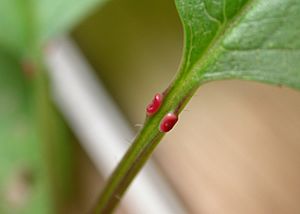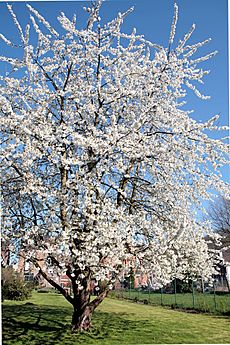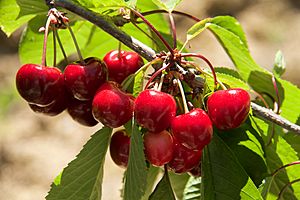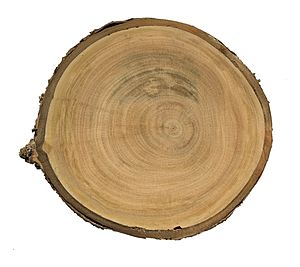Wild cherry facts for kids
Quick facts for kids Wild cherry |
|
|---|---|
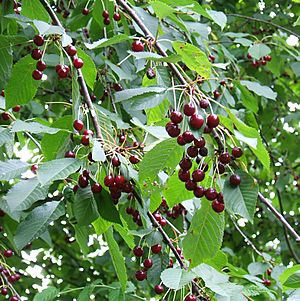 |
|
| Conservation status | |
| Scientific classification | |
| Genus: |
Prunus
|
| Species: |
avium
|
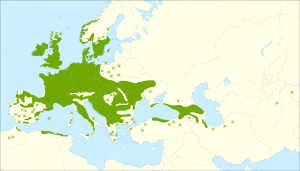 |
|
| Distribution map | |
The Prunus avium, also known as wild cherry or sweet cherry, is a type of cherry tree. It's a flowering plant that belongs to the rose family, called Rosaceae. This tree originally comes from Europe, parts of Asia, and Maghreb in North Africa. You can find it growing naturally from the British Isles all the way to Morocco and Tunisia, and east to the Caucasus mountains and northern Iran. It even has a small group of trees in the western Himalaya. People now grow this tree in many other places, and it has started growing on its own in North America and Australia.
The Prunus avium tree has sixteen chromosomes. It's important to know that almost all parts of the plant, except for the ripe fruit, are a little bit toxic. They contain natural chemicals called cyanogenic glycosides.
Contents
What Does the Wild Cherry Tree Look Like?
The wild cherry is a deciduous tree, which means it loses its leaves in autumn. It can grow very tall, from about 15 to 32 meters (50 to 105 feet) high. Its trunk can be as wide as 1.5 meters (5 feet). When the trees are young, they often have a straight trunk and a cone-shaped top. As they get older, their shape becomes more rounded or uneven.
- The bark of young trees is smooth and purplish-brown, with noticeable grey-brown marks called lenticels. On older trees, the bark becomes thick, dark blackish-brown, and has cracks.
- The leaves are arranged alternately on the branches. They are oval-shaped with a pointed tip, usually 7 to 14 cm (3 to 5.5 inches) long and 4 to 7 cm (1.5 to 3 inches) wide. The top of the leaves is usually smooth and green, while the underside might be slightly fuzzy. The edges of the leaves are serrated (like a saw blade) and have small red glands. The leaf stem, called a petiole, is 2 to 3.5 cm (0.8 to 1.4 inches) long and also has a few small red glands. In autumn, the leaves turn beautiful shades of orange, pink, or red before they fall off.
- The flowers appear in early spring, at the same time as the new leaves. They grow in clusters of two to six flowers. Each flower hangs down on a stalk about 2 to 5 cm (0.8 to 2 inches) long. The flowers are 2.5 to 3.5 cm (1 to 1.4 inches) wide and have five pure white petals, yellowish stamens, and a ovary at the top. They have both male and female parts and are pollinated by bees.
- The fruit is a type of fruit called a drupe. It's usually 1 to 2 cm (0.4 to 0.8 inches) wide, but some cultivated types can be larger. When ripe in midsummer, the fruit is bright red to dark purple. It's edible, and its taste can range from sweet to a bit tart or bitter when eaten fresh. Each fruit has a single hard stone inside, which contains the seed (kernel).
Naming the Wild Cherry
The way this tree was first named and classified was a bit confusing. In 1753, a famous scientist named Carl Linnaeus first called it a variety of another cherry, Prunus cerasus var. avium. He later changed it to its own species, Prunus avium, in 1755.
Historically, the sweet cherry was also known as gean or mazzard. These names are not used much in English today. The name "wild cherry" is also sometimes used for other types of Prunus trees that grow naturally in their habitats, especially a North American species called Prunus serotina.
The scientific name Prunus avium means "bird cherry" in Latin. However, in English, the name "bird cherry" usually refers to a different tree, Prunus padus.
What is a Mazzard?
The term 'Mazzard' can refer to a special type of P. avium that can pollinate itself and grows true from its seeds. These are often used as a base for grafting other fruit-producing cherry trees. This term is especially used for varieties grown in North Devon, England.
How Wild Cherry Trees Live and Grow
Wild cherry fruits are a favorite food for many kinds of birds and mammals. These animals eat the fruit and then spread the seeds in their droppings, helping new trees grow. Some rodents and a few birds, like the hawfinch, can even crack open the hard stones to eat the seed inside.
The leaves of the wild cherry tree also provide food for some animals, including certain Lepidoptera (moths and butterflies).
If the bark of the tree gets a wound, it releases a sticky gum. This gum helps seal the wound, protecting the tree from insects and fungal infections.
Scientists believe that Prunus avium is one of the parent trees of Prunus cerasus, which is known as the sour cherry. This happened through ancient crosses between Prunus avium and Prunus fruticosa (dwarf cherry) in areas where these two species grew close together. All three of these cherry species can breed with each other. Prunus cerasus is now its own distinct species.
Growing Wild Cherry Trees
People often grow Prunus avium as an ornamental tree for its beautiful flowers. Because it can grow very large, it's often planted in parks rather than small gardens or along streets. A popular type grown is 'Plena', which has double flowers, meaning it has more petals than the wild single-flowered forms. In the UK, 'Plena' has even won an award for its gardening merit.
There are also two hybrid trees, P. × schmittii and P. × fontenesiana, which are grown for their beauty. These are crosses between P. avium and other Prunus species.
Uses of the Wild Cherry Tree
Fruit
Wild cherries have been a food source for humans for thousands of years. Archeologists have found cherry stones in ancient settlements from the Bronze Age across Europe, including in Britain. For example, cherry seeds were found at a Bronze Age site in Italy, dating back to around 2077 BCE.
By 800 BCE, people were actively growing cherries in Asia Minor and soon after in Greece.
The sweet cherry is the main ancestor of most of the cultivated cherries we eat today. It's one of the two main cherry species that provide most of the world's commercial edible cherries. The other is the sour cherry, which is mostly used for cooking.
Today, many different types of cherry trees are grown all over the world where the climate is suitable. The wild cherry has also escaped from farms and started growing naturally in some temperate areas, like parts of Canada, Japan, New Zealand, and the United States.
Timber
The wood from the wild cherry tree is hard and reddish-brown. It's highly valued as a hardwood for making things like turned wood items, cabinets, and musical instruments. In North America, cherry wood is also used for smoking foods, especially meats, because it gives them a unique and pleasant flavor.
Other Uses
The gum that comes from wounds in the bark has a nice smell and can be chewed like chewing gum. People can also make medicine from the stalks of the fruit. This medicine can help with things like coughs and can act as a diuretic (helping the body get rid of extra water).
A green dye can also be made from the plant.
Wild cherry trees are widely used in Europe to plant new forests on farmland. They are also important for wildlife and for making areas look nice. Many European countries have programs to protect the genes of wild cherry trees and to breed new varieties.
History and Culture
The ancient Roman writer Pliny wrote about plums (Prunus) and cherries (Cerasus). He mentioned many types of cherries, some sweet and some tart. He even claimed that before a Roman general named Lucius Licinius Lucullus brought cherries from Pontus (a region in Asia Minor) in 74 BC, there were no cherry trees in Italy. He said that in 120 years, they had spread across Europe to Britain.
However, we now know that wild cherry trees were native to most of Europe, including Britain, long before Lucullus. Evidence of people eating wild cherries has been found in archaeological sites from the Bronze Age across Europe. This suggests that what Lucullus brought back was probably a special, cultivated type of Prunus avium from the Caucasus region, not the tree itself.
Modern cultivated cherries are different from wild ones because their fruits are much larger, about 2 to 3 cm (0.8 to 1.2 inches) wide. Farmers often grow these trees on special rootstocks that keep them smaller, making it easier to pick the fruit.
In the 15th century in London, people would shout "Cherries on the ryse" (cherries on the twigs) as a street cry, likely selling the fruit of the native wild cherry tree. The cultivated cherry was brought back to Britain in the 16th century by the fruiterer of King Henry VIII, who planted a cherry orchard in Teynham.
See also
 In Spanish: Prunus avium para niños
In Spanish: Prunus avium para niños



